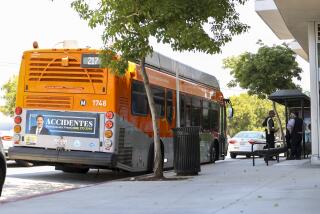Cost of MTA Spinoff Plans Announced : Transit: First-year subsidies of $37 million for a separate Valley line and $20 million to expand Foothill Transit are not enough, critics say.
- Share via
The Metropolitan Transportation Authority staff has put a price tag on the further breakup of the MTA bus system, and the numbers appear to fall well short of satisfying critics in the San Fernando and San Gabriel valleys.
Under discussion are proposals for the MTA to spin off a separate bus line in the San Fernando Valley and to expand the Foothill Transit system into Pasadena and other cities in the San Gabriel Valley.
The debate over how best to manage bus service across the region has long-term implications for riders and for the health of the various agencies. In a debate with parallels to the San Fernando Valley secession controversy, some argue that local control will improve service without rate hikes, but the two sides radically differ on how the various agencies should split their assets and revenues.
In a new study, MTA chief Julian Burke proposed first-year operating subsidies of $20 million for Foothill Transit and $37 million for the Valley.
Put another way, the subsidies would amount to $68 for each hour a bus is operated by Foothill and $69 an hour for each bus operated by the proposed San Fernando Valley bus line. Foothill had proposed a subsidy of $85 an hour, so the agencies are far apart.
Currently, it costs the MTA a minimum of $105 an hour to operate each bus, and officials say that figure constantly goes up.
While leaving open the possibility of raising the subsidies, Burke said in a memo to the MTA Board of Directors that he thinks the proposed subsidies are adequate to allow the divestiture process to continue.
But Foothill Transit Director Julie Austin said the proposed subsidy was so low that it would be pointless to continue negotiations unless the MTA is willing to dramatically increase its share of operating costs of the new bus systems.
“Only $20 million in operating subsidies on a $65-million budget is not going to get us started,” Austin said.
Los Angeles city officials were still studying the proposal. The proposed San Fernando Valley bus line, which would swallow about 18% of current MTA bus operations, would be operated by a joint-powers authority that would include the cities of Los Angeles, Burbank, Glendale and San Fernando.
*
Philip Aker, a planner with the Los Angeles Department of Transportation, said the city is approaching the possible MTA divestiture of its Valley operations cautiously.
“The joint-powers authority will actually write the checks to the people who drive the buses, and it is quite possible that those checks could add up to more than the MTA suggests in its analysis,” Aker said.
Complicating the negotiations is proposed legislation that would force other transit operators to abide by existing union contracts with MTA drivers.
Backed by majority Democrats, the bill is sponsored by four major unions, including the United Transportation Union, which represents MTA drivers.
Foothill Transit, which now serves San Gabriel, West Covina and many other cities, boasts that it is able to run buses better and cheaper than the MTA and can do so because it is able to contract with private firms for drivers and other services.
But MTA drivers say Foothill drivers receive lower pay and benefits and have vowed that mistakes they made with Foothill will not be repeated.
“The whole idea is that a local transit authority could operate a bus system in the Valley more effectively, at a lower cost, with better service,” said David W. Fleming, who chairs the Economic Alliance of the San Fernando Valley and has been a strong proponent of a locally operated and managed bus system. “But if you take all this tremendous [MTA] overhead and move it to a new agency, all you’ve done is transfer it. Local control is meaningless if you don’t have the dollars to do something with it.”
Allan Lipsky, MTA’s chief operating officer, defended the size of the proposed subsidies, saying the transit agency simply wanted to break even, not make money.
“We have to demonstrate that splitting off bus service would have a net benefit to countywide transportation,” he said, citing a state law that set up the MTA. “To work, MTA passengers would have to get the same or better service, without costs increasing overall.”
The proposed breakup contemplates a three-year trial period, at the end of which the new transit systems would be on their own if they could be financially self-supporting, Lipsky said.
At that point, money would come in from fare box collections and state and federal subsidies, the way MTA currently operates.
More to Read
Sign up for Essential California
The most important California stories and recommendations in your inbox every morning.
You may occasionally receive promotional content from the Los Angeles Times.










